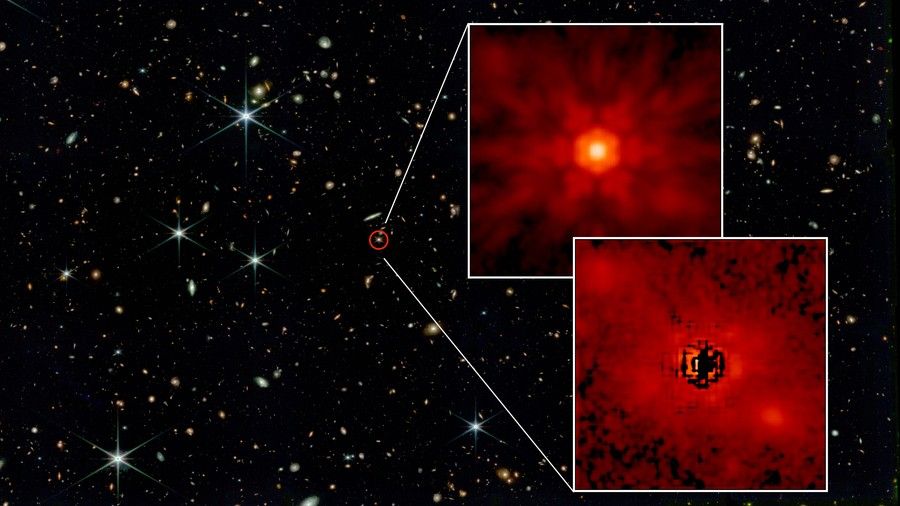The James Webb Space Telescope (JWST) has delivered a groundbreaking discovery, rewriting our understanding of black hole formation in the nascent universe.
This cosmic revelation unveils the most distant pair of merging black holes ever observed, challenging prevailing cosmological theories and forcing us to re-evaluate how these monstrous entities formed so early in existence.

Monsters of the Primordial Era: Black Holes Collide at Cosmic Dawn
Imagine peering deep into the cosmos, 13 billion light-years back to a time just 740 million years after the Big Bang. Here, within the swirling chaos of a galaxy system known as ZS7, resides a spectacle unlike any ever witnessed before. JWST’s keen infrared vision unveils two colossal black holes, each estimated to be a staggering 50 million solar masses, locked in a gravitational dance of doom. This impending merger, the farthest such event ever detected, throws a wrench into our current understanding of black hole formation.
A Challenge to Cosmology: How Did These Giants Arise?
Leading cosmological theories grapple with the existence of such massive black holes at such an early epoch. The conventional wisdom suggests that black holes form from the collapse of massive stars, a process that takes time. The sheer size of these primordial black holes in the ZS7 system defies this notion, forcing us to consider alternative explanations for their rapid growth. Were there perhaps different physical laws governing the universe in its infancy, allowing for the formation of supermassive black holes through more exotic mechanisms? JWST’s discovery compels us to explore these possibilities and refine our cosmological models.
Merging Monsters: A Path to Supermassive Black Holes?
The discovery of these merging black holes offers a compelling new piece to the puzzle. Astronomers believe that supermassive black holes, behemoths millions to billions of times the sun’s mass, may grow through the very process observed in ZS7 – the merging of large black holes. This observation suggests that such mergers may be a crucial mechanism for the rapid growth of black holes in the early universe, a theory supported by other recent JWST findings of active, massive black holes in distant galaxies. The merging of these black holes within ZS7 may be the first act in a grand play, leading to the formation of a supermassive black hole that will dominate the evolution of its host galaxy.
The JWST Revolution: Unveiling the Universe’s Secrets
The James Webb Space Telescope is revolutionizing our understanding of the cosmos. Its unparalleled capabilities pierce through cosmic dust and allow us to peer back to a time shortly after the Big Bang. This discovery of the monstrously massive black holes in ZS7 is a testament to JWST’s power and a harbinger of the many groundbreaking discoveries yet to come. As we delve deeper into the secrets of the infant universe, the JWST will continue to challenge our existing paradigms and reshape our cosmic perspective. The colosseum of the early universe unfolds before our eyes, filled with unforeseen phenomena and demanding a complete rewrite of the cosmic rulebook. With JWST as our guide, we embark on a thrilling journey of exploration, forever altering our understanding of the birth and evolution of these monstrous black holes and the universe they inhabit.



















